(click on photos to enlarge image)
MARKS OF EUROPEAN SILVER PLATE:
XII. FRAGET, RUSSIA/POLAND
(Revised & Updated Version of Members' Window # 57)
Three years ago I published a Members' Window in ASCAS
newsletter devoted to the Warsaw silver plate factories Fraget
and Norblin [1]. This study was unexpectedly well appreciated by
the readers; I got more than fifty letters. Most of them were
not from Polish or Russian audience, they came from the people,
whose grandparents or great grandparents at the beginning of the
XXth century left the Russian Empire in the hope of finding a
better life on the other side of the Atlantic Ocean. As a memory
of their previous life, these immigrants often took with them a
small inexpensive silver-plated piece, something like a
tea-glass holder, a pair of candlesticks or sugar tongs. Now
their grandchildren or great grandchildren write to me to know
more about these memorabilia, where they were coming from and
when they were produced.
It's interesting and a little bit strange, but in the beginning
of the XIXth century, just after the Russian victory in the war with
Napoleon, the situation was quite the opposite, there was a
great flow of immigrants from Europe to Russia. Among the
numerous craftsmen, teachers, governesses, scientists, engineers,
etc. coming to Russia, there were a small number of talented
jewellers, who moved from France and Germany to Warsaw, capital
of the newly-annexed (1815) Polish Kingdom, to organize the
production of silver-plated tableware. The Russian government
was giving significant privileges to these new factory-owners in
the Polish Kingdom, including the possibility of tax-free trade
throughout the Russia. Besides, as Warsaw was not too distant
from the main European centres of silver-plate production, this
facilitated the purchase of equipment, raw materials and/or
getting the necessary information. As a result, in 1850-1860, the
first Russian factories producing inexpensive silver-plated tableware
by cutting-edge electrolysis technology were built there. By the end
of the XIXth century practically all Russian manufacturing of
silver-plated tableware and utensils was concentrated in Warsaw.
It should be reminded that before 1850 in Russia all
silver-plated objects were produced by soldering of a thin sheet
of silver to a red-heated copper plate with subsequent rolling
[2,3]. Such copper base with a fused silver layer was called
"SILVER PLATE" or simply "PLATE" ("PLAQUÉ" in French, "PLATER"
in Polish). However, in the second quarter of the XIXth century
a revolutionary method of silver deposition on the surface of a
base metal using the electrolysis process under high voltage was
invented (the first patent was given to the Elkington cousins in
England in 1840) and successfully applied by Christofle in
France in 1844. The great advantage of this "galvanic" approach
was the possibility of a very thin silver layer deposition,
which led to the economic consumption of precious metal and a
significant decrease in price for the final product. To the end
of the XIXth century the galvanic method of silver deposition
practically replaced the former soldering-based silver plating
technique. Nevertheless, until now in Polish and English
literature the confusion remains, the Polish term "PLATER" and
the English term "PLATE" refer simultaneously to both, old (fusion-based)
and new (galvanic) silver deposition techniques.
This article is devoted to the famous Warsaw jewellery company
Józef Fraget, renowned pioneer in galvanic silver plate
production. The firm was founded in 1824 by two French
businessmen, the brothers Alphonse (in Polish Alfons) and Joseph
(in Polish Józef, 1797-1867) Fraget [4,5,6]. Around 1845
Alphonse Fraget left the business and returned to France while
Joseph became the sole owner of the firm, which survived until
1939 under the name Józef Fraget (in Polish), or
 (in Russian). In 1836 Joseph married the daughter of the Berlin
jeweller Amalia Steffen (1805-1868). In 1847 he was travelling
throughout Europe and studying the newest technology of galvanic
silver deposition on copper and brass used by Christofle & Co.
in Paris, France. After his return to Warsaw, in 1849 he totally
refurbished the factory, adding a smelting department for the
preparation of Neusilber (Alpaca) alloy and a laboratory for
galvanic studies. Somewhat later, in 1857, he purchased in
Austria-Hungary a unique machine for the mass production of
Neusilber-based cutlery, 150 dozens per day. The number of
workers employed by the factory quickly grew from 150 in 1847 to
240 in 1859 and 400 in 1900. Soon the inexpensive silver plate
production of his company became so popular in Russian Empire
that all the silver-plated items were named simply by "fraget".
(in Russian). In 1836 Joseph married the daughter of the Berlin
jeweller Amalia Steffen (1805-1868). In 1847 he was travelling
throughout Europe and studying the newest technology of galvanic
silver deposition on copper and brass used by Christofle & Co.
in Paris, France. After his return to Warsaw, in 1849 he totally
refurbished the factory, adding a smelting department for the
preparation of Neusilber (Alpaca) alloy and a laboratory for
galvanic studies. Somewhat later, in 1857, he purchased in
Austria-Hungary a unique machine for the mass production of
Neusilber-based cutlery, 150 dozens per day. The number of
workers employed by the factory quickly grew from 150 in 1847 to
240 in 1859 and 400 in 1900. Soon the inexpensive silver plate
production of his company became so popular in Russian Empire
that all the silver-plated items were named simply by "fraget".
In 1867 Józef Fraget died and his son Julian Fraget (1841-1906)
became the manager of the company. In 1868 Julian married a
Polish girl of French origin, Antonina de Sauve (1850-1925). In
1896 the firm Józef Fraget participated in the All-Russia Trade
Fair in Nizhnii Novgorod and deservedly was honoured by the
right of using the image of the Russian State Coat of Arms (two-headed
eagle) on its products. In 1897 the firm was transformed into a
joint-stock company "Fabryka Wyrobów Platerowanych Józef Fraget",
which in translation means "Silver Plate Factory Józef Fraget".
After the tragic death of Julian Fraget in 1906, the guidance of
the company was taken by his daughter, countess Maria
Swiatopelk-Mirska (1841-1938).
After the death of Maria, her son Józef Swiatopelk-Mirski
became the last manager of the firm. In 1939 with the occupation
of Poland by the Nazis, the firm Fraget stopped its production.
After World War II, in 1945, the factory was reopened, but then
nationalized. Finally, in 1965 Fraget was merged with another
Warsaw silver plate foundry, Brothers Henneberg, to form a new
state company "HEFRA".
After this long introduction, I am presenting an updated list of the hollow ware marks used by Józef Fraget firm.
Marks used by Józef Fraget factory.
|
N°
|
PERIOD & MARK
|
COMMENT
|
|
1
|
c.1840 - c.1851
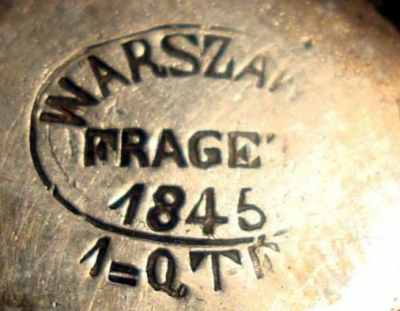
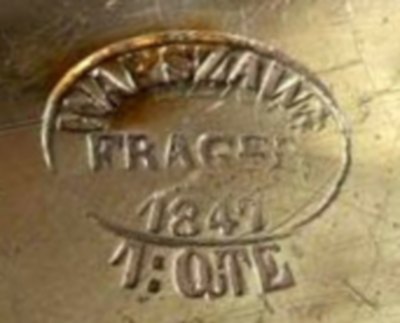
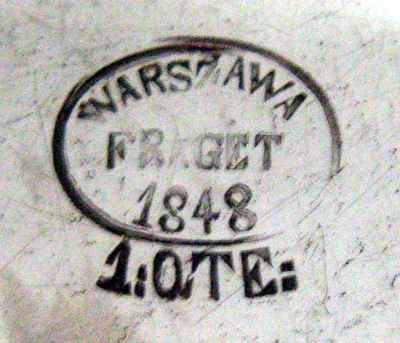
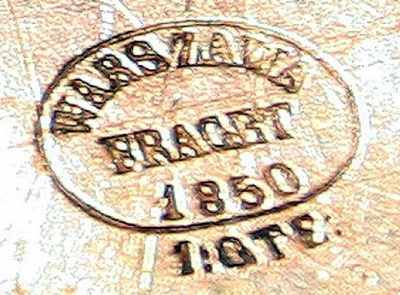
|
The earliest mark of Fraget
at my disposal. It refers to fusion-based silver
deposition. It has the inscription in Polish "WARSZAWA
FRAGET" ("WARSAW FRAGET") + the year of production
inside the oval. Under the oval is the French
inscription "1 QTÉ" (shortening of 1 QUALITÉ, which
means "highest quality"). Small changes in writing of
"1 QTE" inscription from year to year should be
emphasized. Rare.
|
|
2
|
c.1851 - c.1853
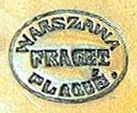
|
This Fraget mark also refers to
fusion-based silver deposition. It has the
inscription in Polish "WARSZAWA FRAGET" ("WARSAW
FRAGET") + one French word "PLAQUÉ" inside the oval.
Note the dot (!) after the word "PLAQUÉ". Very rare.
|
|
3
|
c.1851 - c.1853
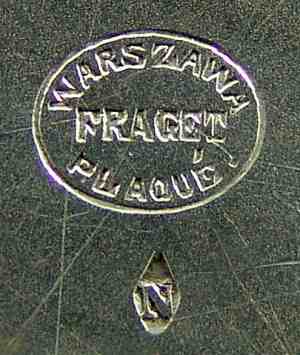
|
First
Fraget mark which refers to galvanic-based silver
deposition.
It has the inscription in Polish "WARSZAWA FRAGET" ("WARSAW
FRAGET") + one French word "PLAQUÉ" put inside the oval.
Note the dot (!) after the word "PLAQUÉ". In
addition, the rhombus with "N" letter, which means "normal
thickness of silver deposited onto the surface of
the base metal (usually on brass)". In the case of
double silver layer, the letter "D" was used. Very
rare.
|
|
4
|
c.1853 - c.1860
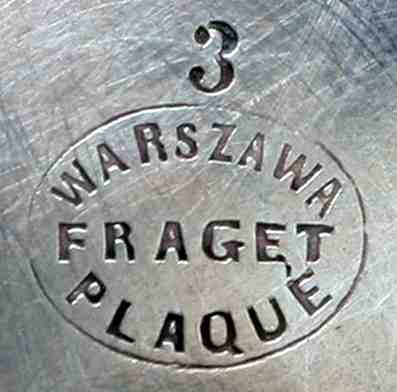
|
A variation of the mark
No.2 with long writing of the word "FRAGET". Refers
to fusion-based silver deposition. It has the
inscription in Polish "WARSZAWA FRAGET" ("WARSAW
FRAGET") + French word "PLAQUÉ" inside the oval.
Note the absence of the dot (!) after the word "PLAQUÉ".
Very rare.
|
|
5
|
c.1853 - c.1860
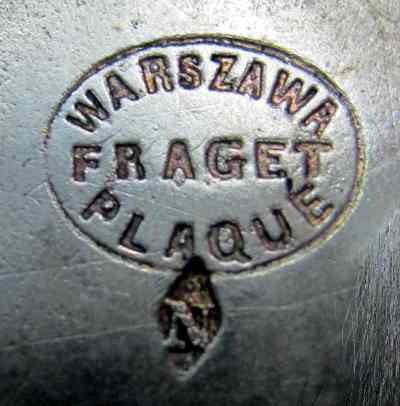
|
A variation of the mark
No.3 with long writing of the word “FRAGET”. Refers
to galvanic-based silver deposition. It consists of
the inscription in Polish "WARSZAWA FRAGET" ("WARSAW
FRAGET") + French word "PLAQUÉ" put inside the oval.
Note the absence of the dot (!) after the word "PLAQUÉ".
The size of the oval varies between 7.6 mm x 10.5 mm
and 8.0 mm x 10.7 mm. In addition, the rhombus with
"N" letter is used, which means "normal thickness of
silver deposited onto the surface of the base metal
(usually on brass)". Rare.
|
|
6
|
c.1860 - c.1896
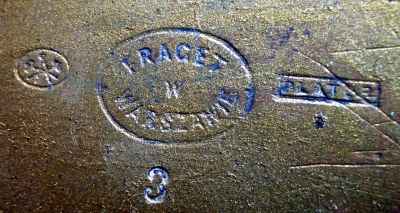
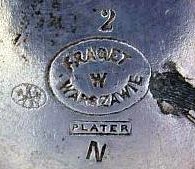

|
This
Fraget mark refers to fusion-based silver
deposition. It has the inscription in Polish
"FRAGET W WARSZAWIE" ("FRAGET IN WARSAW"), put
inside the oval. Near the oval is another Polish
inscription "PLATER" ("PLATE"), put in a cartouche.
Inside the small oval is the coat of arms of the
coppersmiths’ and bronze-smiths' corporation (two
crossed hammers with a pair of compasses). Sometimes
this sign is given twice. Rare.
|
|
7
|
c.1860 - c.1896
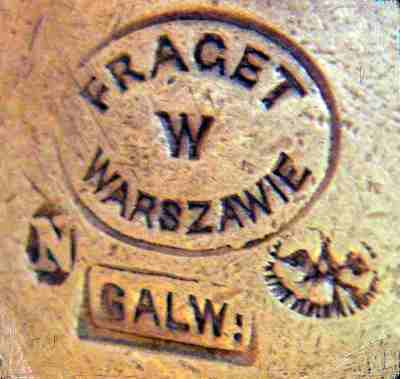
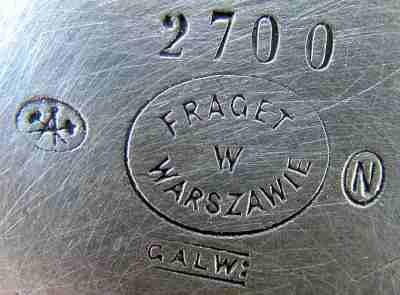
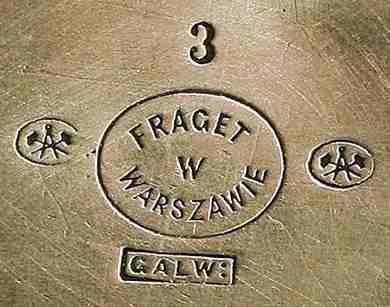
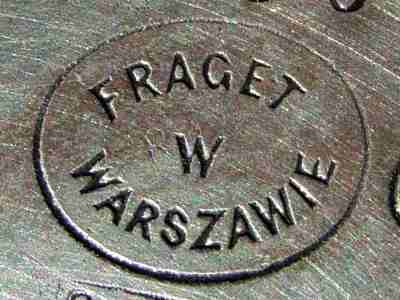
|
This
Fraget mark refers to galvanic-based silver
deposition. It has the inscription in Polish
"FRAGET W WARSZAWIE ("FRAGET IN WARSAW") inside the
oval. The size of the oval varies between 7.5 mm x
9.9 mm and 8.0 mm x 10.4 mm. The rhombus (or the
small oval) with "N" letter means "normal thickness
of silver deposited onto the surface of the base
metal usually on brass)".
The inscription "GALW" in a cartouche is the
shortening of Polish word "GALWANIZACJA" ("GALVANIZATION"),
explaining the method of silver deposition. Note the
colon at the end of the inscription "GALW". Inside
the small oval is the coat of arms of the
coppersmiths' and bronze-smiths' corporation (two
crossed hammers with a pair of compasses). Sometimes
this sign is given twice. A widespread mark.
|
|
8
|
c.1896
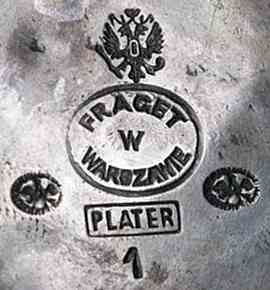
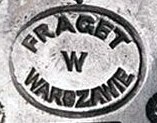

|
This Fraget mark is the
mark No.6, over-printed with the coat of arms of
Russian Empire (two-headed eagle). It is very rare,
which testifies to a total disappearance of the
fusion-based silver plate Fraget production by the
1896.
|
|
9
|
c.1896
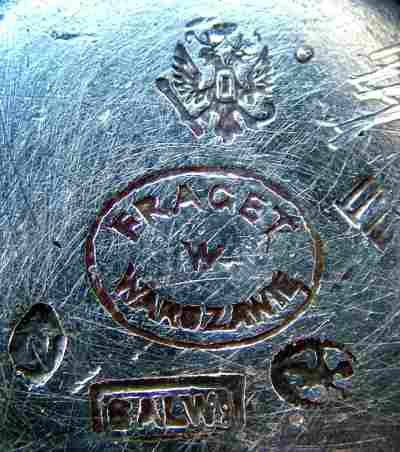
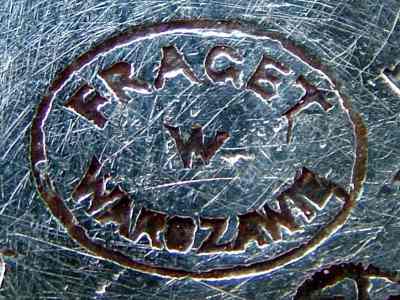
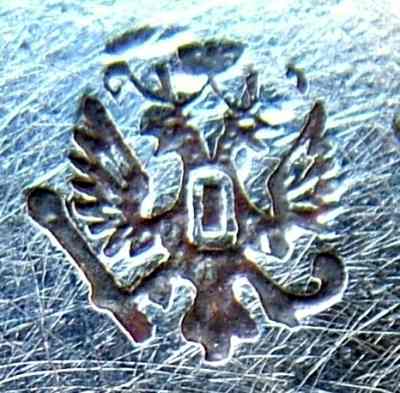
|
This Fraget mark is the
mark No.7, over-printed with the coat of arms of
Russian Empire (two-headed eagle). The size of the
large oval varies between 7.1 mm x 9.4 mm and 7.4 mm
x 10.3 mm. Rare.
|
|
10
|
c.1896 - c.1914
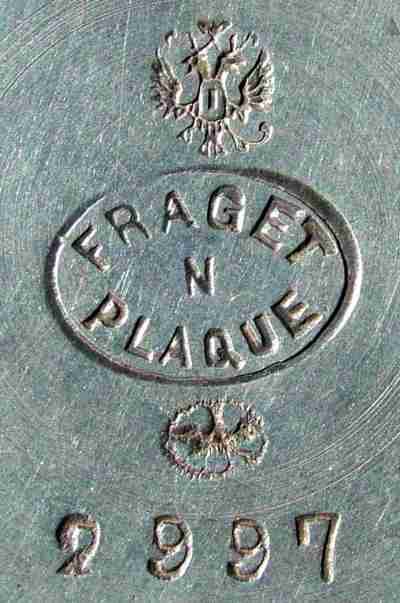
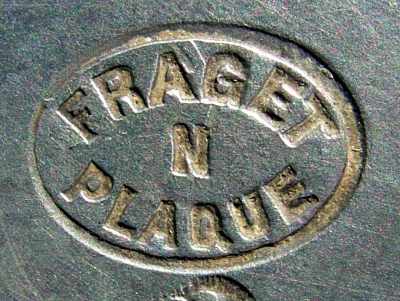
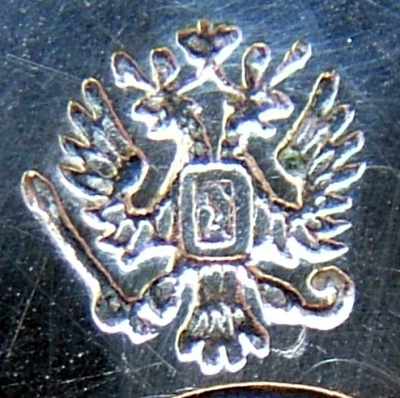
|
A widespread Fraget mark
for marking the hollow ware made by galvanic silver
deposition. It consists of the inscription "FRAGET
PLAQUE" ("FRAGET PLATE") inside the oval. The letter
"N" in the centre of the oval means "silver
deposition onto the brass surface". The size of the
oval varies between 5.2 mm x 7.9 mm and 7.3 mm x
10.5 mm. Above the oval is the coat of arms of
Russian Empire - the two-headed eagle. Inside the
small oval is the coat of arms of the coppersmiths'
and bronze-smiths' corporation (two crossed hammers
with a pair of compasses).
|
|
11
|
c.1896 - c.1914
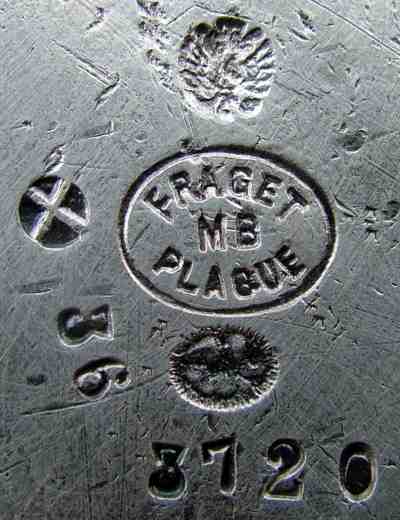
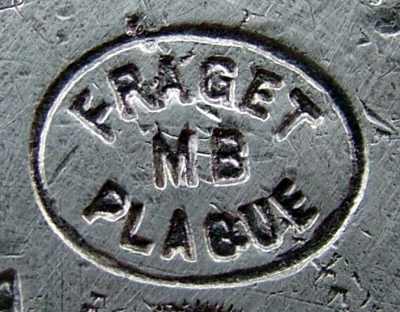
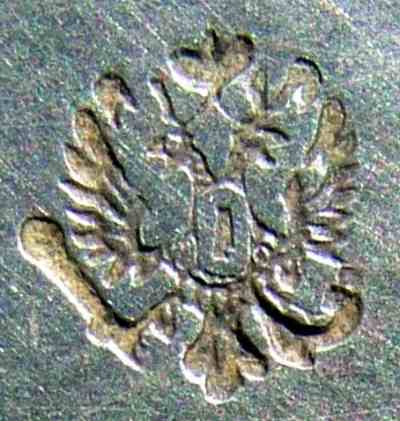
|
Rare Fraget mark for
marking the hollow ware made by galvanic silver
deposition. It consists of the inscription "FRAGET
PLAQUE" ("FRAGET PLATE") inside the oval. The
lettering "MB" in the centre of the oval is the
abbreviation for the French inscription "METAL BLANC"
("white metal" or Alpaca). That means "silver
deposition onto the surface of Alpaca base metal".
The size of the oval varies between 6.2 mm x 8.2 mm
and 6.5 mm x 8.5 mm. Above the oval is the coat of
arms of Russian Empire - the two-headed eagle.
Inside the small oval is the coat of arms of the
coppersmiths' and bronze-smiths' corporation (two
crossed hammers with a pair of compasses).
|
|
12
|
c.1896 - c.1914
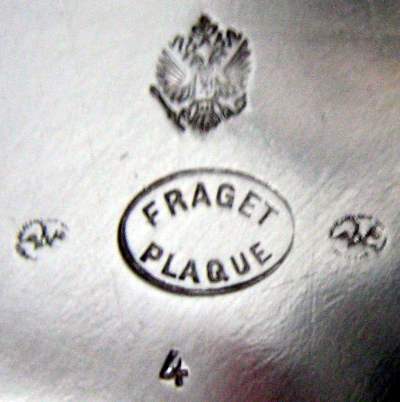
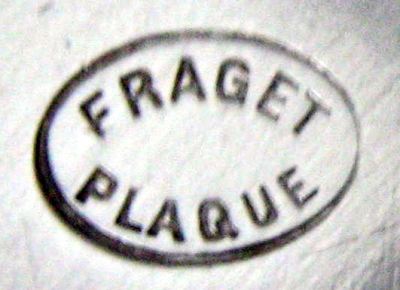
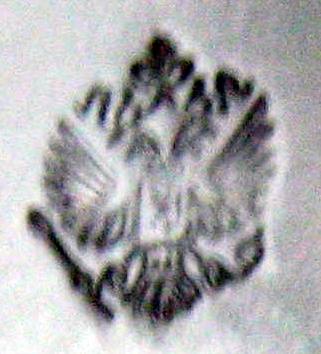
|
A very rare Fraget mark for
marking the hollow ware made by fusion-based silver
deposition onto the copper surface. It consists of
the inscription "FRAGET PLAQUE" ("FRAGET PLATE"),
put inside the oval. Above the oval is the coat of
arms of Russian Empire - the two-headed eagle.
Inside the small oval is the coat of arms of the
coppersmiths' and bronze-smiths' corporation (two
crossed hammers with a pair of compasses). Sometimes
this sign is given twice.
|
|
13
|
After 1914
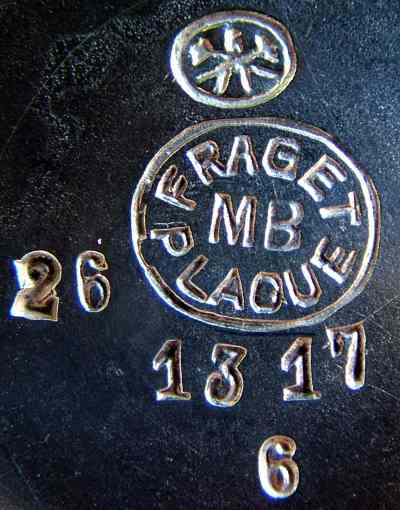
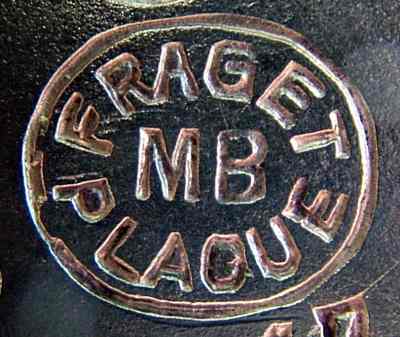
|
A variety of Fraget mark
No.11 with the absence of the coat of arms of
Russian Empire.
|
|
14
|
After 1914
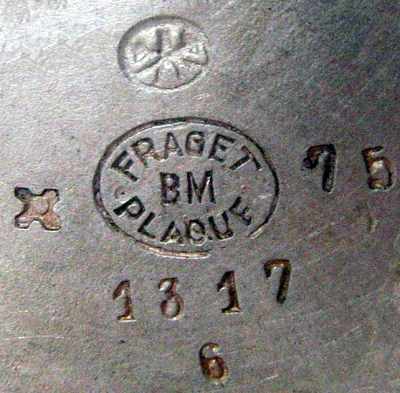
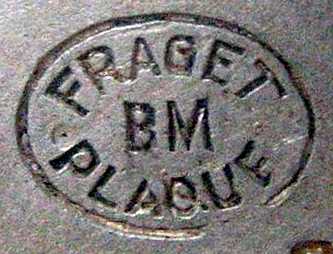
|
Another later variety of
Fraget mark No.11. Besides the absence of the coat
of arms of Russian Empire, it contains the lettering
"BM" in the centre of the oval (instead of the
previous "MB" lettering). I think it is the same
marking of Alpaca base metal, but made in Polish, as
two letters "BM" could be the abbreviation for "BIALY
METAL" ("white metal" in Polish).
|
Acknowledgements
I would like to acknowledge the help of two people, Mr.
Sergei Kruglov, who shared with me the photographs of Fraget
marks from his collection of tea glass holders, and Dr. Jan
Kozlowski, who kindly sent me the copies of two Fraget
catalogues and the reprint of an earlier work of Joanna
Paprocka on the same subject. My e-mail address is niko@phys.ucc.ie.
Any comments, questions or letters with additional
information are very welcome. However, please do not send
any requests for valuation and/or expertise, such letters
will be ignored.
LITERATURE
[1] David N. Nikogosyan. Marks of European Silver Plate: II.
Fraget & Norblin, Poland/Russia.
http://www.silvercollection.it/ASCASFRAGET.html, 2009.
[2] Svetlana Kaikova. Silver Replacement Techniques in Russia.
Antiques, Art and Collectables, N°1, pp.65-78 (2002) [in Russian].
[3] Elena Elkova. "Plaqué" and "Doublé" Techniques in French
Silver Plate Production. Antiques, Art and Collectables, N°4
(46), pp.76-84 (2007) [in Russian].
[4] Joanna Paprocka, Srebra i Platery Firmy Józef Fraget.
Warszawa: Wydawnictwo Naukowe PWN, 1992, pp.1-97 [in Polish].
English translation: Joanna Paprocka, Silver and Silver-Plated
Items Produced by Józef Fraget Company.
[5] Joanna Paprocka-Gajek. Platery Warszawskie w Latach
1822-1914. Warszawa: Muzeum Palac w
Wilanowie, 2010, pp.1-375 [in Polish]. English translation:
Silver Plated Items produced by Warsaw factories in 1822-1914.
[6] Maria Ejchmann. Platery. Katalog Zbioru Platerów
Warszawskich im. Anieli i Tadeusza Wysiadeckich. Warszawa:
Muzeum Woli, 2005, pp. 1-107 [in Polish]. English translation:
Warsaw Silver Plate. Catalogue of the collection, gathered by
Aniela and Tadeusz Wysiadecki.
Dr. David N. Nikogosyan
- 2012 -
|
|

